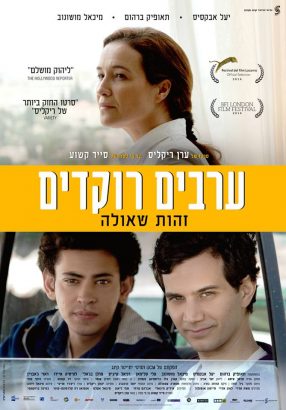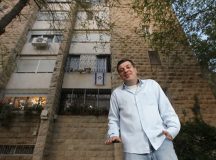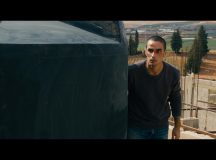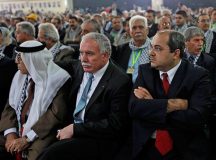A review of Dancing Arabs (Aravim Rokdim) by Eran Riklis (Director) and Sayed Kashua (screenwriter).
The critically acclaimed 1996 film, Lone Star, directed by the celebrated leftist American filmmaker, John Sayles, ends with a surprising revelation. Indicating just how intimate (incestuous even) Mexican and Anglo-American identities have become in the Southwest region of the United States, a man and a woman (played by co-stars Elizabeth Peña and Chris Cooper) discover that they share more in common than they’d ever imagined. Barely a century-and-a-half after the territories of California, New Mexico and Texas were occupied and annexed by the proprietors of Britain’s former colonies on the East Coast of North America, it’s already harder than you might think to disentangle family from familia – especially at night – in the hybrid mestizo/a spaces of la frontera. Fences haven’t kept neighbours apart at all (good fences aren’t really meant to and bad ones really can’t).
Indeed, only the illusion of fixed, immutable borders, Sayles’s film implies, prevents both ‘sides’ (the reality is, of course, far more complex than the binary would suggest) from recognising each other as (literally) brothers and sisters who (ahem, literally, once again) love one another. In the New World prior to the 20th century, imperial Spain’s conquered colonies became Mexico’s administered provinces which became, in rapid succession, Washington’s territorial mandate. Manifestly, the destiny of the various peoples of the region was to live together, willy-nilly, learning to speak, read and write each other’s languages (and sharing other things too). But on whose terms?
Gazes averted onto an open horizon, Peña and Cooper stare in unbelief across a Texas plain, vowing to – in the film’s unforgettable last line – ‘Forget the Alamo!’ But it’s easier to imagine the on-screen lovers going ahead with their private life together – in bold if ultimately inconsequential disregard of the oppressive weight of an unusable past which threatens to separate them – than it is to contemplate how the film’s audience, more consequentially, might redraw the map of its real-life world in order to live together as harmoniously. In other words, the ideological work in the case of this late example of the mystery genre – whatever the director’s intentions – is basically conservative. It trades in substitute gratifications, ultimately, for the object of the utopian longings (for a transformed reality) that it stimulates. The ‘content of the form’ (individualistic, heteronormative) serves to ‘contain’ or limit the implications of the drama’s own representations at their most radical.[1]
In other words, by suggesting an ‘imaginary resolution to the real contradictions’ (Althusser) of conflict-ridden life in a war-torn region – according to Hollywood’s durable codes of heterosexual romance as the obvious solution to everything – Sayles inevitably sidesteps the very issues of immigration, labour, racism, imperialism and neo-liberalism that his film raises so powerfully up to that point. The unification of the film’s attractive fictional dyad across ethnic lines in fantasy serves to elide the fact of ongoing social, political, and economic division, difference and antagonism in reality. Since Sayles is a great director, however, he knows this, and takes pains to signal as much to the viewer. Lone Star is a masterpiece of its kind, on a par with the novels of E. L. Doctorow for their active, intelligent, defamiliarising engagement with representations of history from a progressive point of view.
*
Director Eran Riklis and screenwriter Sayed Kashua’s 2014 collaboration, Dancing Arabs (Aravim Rokdim), is not exactly the Israeli equivalent of the Sayles cult-classic, or quite as good (although it is very good). The scope is smaller in this case and more personal, the sweep of history that the Israeli film seeks to capture less ambitious. Nevertheless, this joint Israeli-German-French co-production shares both some of the American film’s sublimated ‘desire of the Other’ (Lacan) and much of its left-utopian dream of undermining defensive barriers to peace and justice in a loving/erotic embrace which reconfigures identity in a subversive exchange conducted at the level of bodies. Both pictures blur the line between self and other, public and private, I and thou, personal and political, essence and existence – challenging audiences to ask themselves who they think they are, to check and see if they really know so well after all. Indeed, by the end of the Riklis/Kashua film, Jew has become Arab and Arab, Jew, while both remaining Israeli – and the future of what this means is deliberately marked as uncertain/unwritten, open for discussion.
One of them is dead, however. And the other, who has literally taken his place, is profoundly conflicted about having chosen to live as someone else – adopting the deceased’s sloughed-off identity while sloughing-off his own. For only after the Arab Israeli protagonist, Eyad (played memorably by Tawfeek Barhom), has buried the corpse of his Jewish friend in a Muslim cemetery under an assumed name (Eyad’s own), can the survivor’s self-transformation be complete. Eyad becomes Jonathan (Michael Moshonov) with the blessing of the latter’s mother (Yael Abecassis), who nurtures the substitution – as she accepts that her ‘original’ son’s time is up, while the foster son’s ought properly to be just beginning. Since only the mild but irritating discrimination he faces as an Arab student in a prestigious boarding school stands in his way – he’s got everything else from looks, brains and courage, to quiet charm and unflagging moral rectitude – the path forward is clear. Finish the process that fate initiated (amor fati!); actually become Jewish, and with that a member of the majority in Israel.
By the end, the Arab friend has the dead Jew’s bankbook and identity card (they’re the same age and look enough alike), along with the gratitude and affection of his mother. In deference to Christology, the father of the sacrifice has duly forsaken him, too (nowhere to be found). Moreover, is the one who comes next in succession not a little like the Last Prophet, therefore? Having gone to school with Jews, Eyad (like Kashua himself: the film is loosely autobiographical in its fundamentals) speaks unaccented Hebrew and has a Jewish girlfriend for a while. Although Naomi (played by Danielle Kitsis) eventually breaks up with him – both at the insistence of her disapproving parents and because she wants to serve in military intelligence when she graduates – she does not do so before conferring on Sayed’s saintly double another kind of affirmation.
Apropos of the protagonist’s overriding moral superiority, there is no overt violence or outward display of aggression in the gentle, melancholy, identity-swapping process. Eyad is neither mad at his Jewish friend nor jealous of him. Nor jubilant at his passing. He’s no terrorist (a stereotype the film has mischievous fun with, as Eyad’s father is arrested for political activity). Instead, this guy cares you to death. As you are terminally ill anyhow and in need of a caretaker/undertaker, he is quickly invited to move in and look after you. He feels sorry for you, even, as he slowly takes your place with the approval of your mom, the pretty girl, and all the kids at school. With the exception of a moment in class one day, when the generally not-so-angry young man courageously stands up to authority in the shape of a teacher who misunderstands him (much to the delight of the classmates who cheer him on), a little bemused self-righteousness and a heart of gold seems to be all it takes to get this job of sympathetic metamorphosis done.
If the stricken invalid – despite his infirmity, still charmingly obsessed with alt-rock music from the confines of a wheelchair and a hospital bed-equipped windowless room – serves as a not-so-subtle metaphor for the imagined paralysis of decadent Jewish Israeli civil society, then his slow, meticulously orchestrated demise is the key to a wish-fulfilment fantasy at the heart of the film. As the literary critic, Rachel Harris, points out in her insightful study of Kashua’s first three novels (on a couple of which the film’s screenplay is partly based), ‘The decision by Arab Muslims [of Kashua’s generation in particular] to write novels in Hebrew demonstrates a new level of integration into the prevailing social codes of Israeli society.’ [2] With this choice and this fact (‘Hebrew and I chose each other,’ Kashua has said in an interview)[3] comes also, along with fame and fortune (critical and popular success have not been coy), ambivalence and even a measure of hostility toward the loved and desired, hated and rejected object – the Jewish state itself. Since the writer and director are both Israeli, one senses that this entails a measure of delicious self-loathing, too, perhaps a certain ‘pride in being ashamed’ to be Arab Israeli? Eyad buries ‘Eyad’ (puts his Arab name and identity to rest) even as he disposes of Jonathan’s (Jewish) body. As an ‘imaginary resolution of the real contradictions’ plaguing a new generation of Arab Israelis now entering maturity (Kashua recently turned 40), Dancing Arabs is resourceful, indeed.
Accused of writing too much about – thus risking taking evident enjoyment in – being mistaken for Jewish by Arabs and Jews alike, a running theme in his Haaretz columns and books as well, Kashua recently seized an opportunity to reassert his Arab-ness, unmistakably, by departing the country he does-and-doesn’t feel a part of, exiting in high dudgeon over last summer’s brutal defensive struggle in response to Hamas’s rockets and tunnels, Operation Protective Edge.
This has meant some relatively strong denunciations of Israel lately, from one of its more patient critics up until now. For example, Israel is no place to raise kids, Haaretz readers were told recently by Kashua, now a visiting professor at the University of Illinois, Urbana-Champaign’s Israel Studies Programme. But as a fiction writer/filmmaker, Kashua gets to have it both ways, with his well-received-in-Israel movie about a fully integrated alter-ego entirely (to all external appearances) at home here. His acronym (Eyad) not only stays in Israel, but blends in perfectly, while the real author (Sayed) goes on making a living at being proud to be ashamed to be Arab Israeli. Doing so brilliantly (and with more appealing humour than this review conveys), he continues to provoke serious thought about the future of both Arab and Jew alike in the Jewish and democratic State of Israel.
If the mushily attractive prospect of ‘forgetting our Middle Eastern Alamo(s)’ (Nakba/War of Independence, Six-Day War, and Intifadas One and Two, not to mention the Holocaust) in Israel/Palestine might not be a realistic option any time soon, then at least remember a couple of things, Kashua/Riklis implore. Preceding the action, some words of the late Palestinian national poet, Mahmoud Darwish (himself quoting the influential Palestinian-American critic, Edward Said) appear on screen, juxtaposed provocatively with a familiar statistic: ‘Identity is self-invention, and not an inheritance of the past … 20 per cent or 1,658,000 Israeli citizens are Arab.’ Since the former citation expresses a half-truth, at best, and the latter number is well-known, then putting the two together is not meant to inform so much as remind (nudge). Riklis Kashua’s art invokes a fervent hope, keep faith with a passionate commitment, conjures a hazy dream, shouts an uncompromising demand: recognise what you already know! And do something … If what exactly remains unclear, a film is, anyway, not a blueprint.
In spite of our disorienting, frustrating directionlessness at the moment, to which Dancing Arabs speaks eloquently, the tempered optimism of the film remains far preferable to Kashua’s own sour, despairing tone of late, displayed in his popular Haaretz columns now written from self-imposed exile in the United States, where he says he’s not coming back from. While the journalist tells us that, as of last July, ‘[T]he lie I’d told my children about a future in which Arabs and Jews share the country equally was over,’ the filmmaker (or at any rate, the film itself) suggests otherwise. As does a look at another statistic: 65 per cent of Israel’s 20 per cent of Arab Israeli citizens report being ‘quite proud or very proud to be Israeli.’ [4] Not bad at all, considering that 15 per cent of Jewish Israeli citizens were themselves less than thrilled. And if for some number of writers and artists hidden among the data this means – almost necessarily, given the antinomian thrust of so much modern/postmodern art – being proud to be ashamed, then that too is a sign of a fundamentally healthy and vibrant liberal-democratic culture, willing and able to look at itself critically.
To my knowledge, Kashua’s books have not yet been translated into Arabic, nor has this must-see film yet been released in Syria, Lebanon, Jordan, or Egypt. In Israel at least, ‘the lie’ of Arab-Jewish cooperation isn’t over yet.
[1] I here draw loosely on one of the most influential theses in cultural studies in the last 30 years, Fredric Jameson’s ‘Reification and Utopia in Mass Culture,’ Social Text, No. 1 (Winter, 1979): 130-148.
[2] Rachel Harris, ‘No Place Like Home: Arab-Israelis, Contemporary Fiction, and an Arab-Hebrew Identity,’ in Cary Nelson and Gabriel Noah Brahm (eds.), The Case Against Academic Boycotts of Israel (New York: MLA Members for Scholars Rights, 2015), 336.
[3] Cited in Harris (337).




































